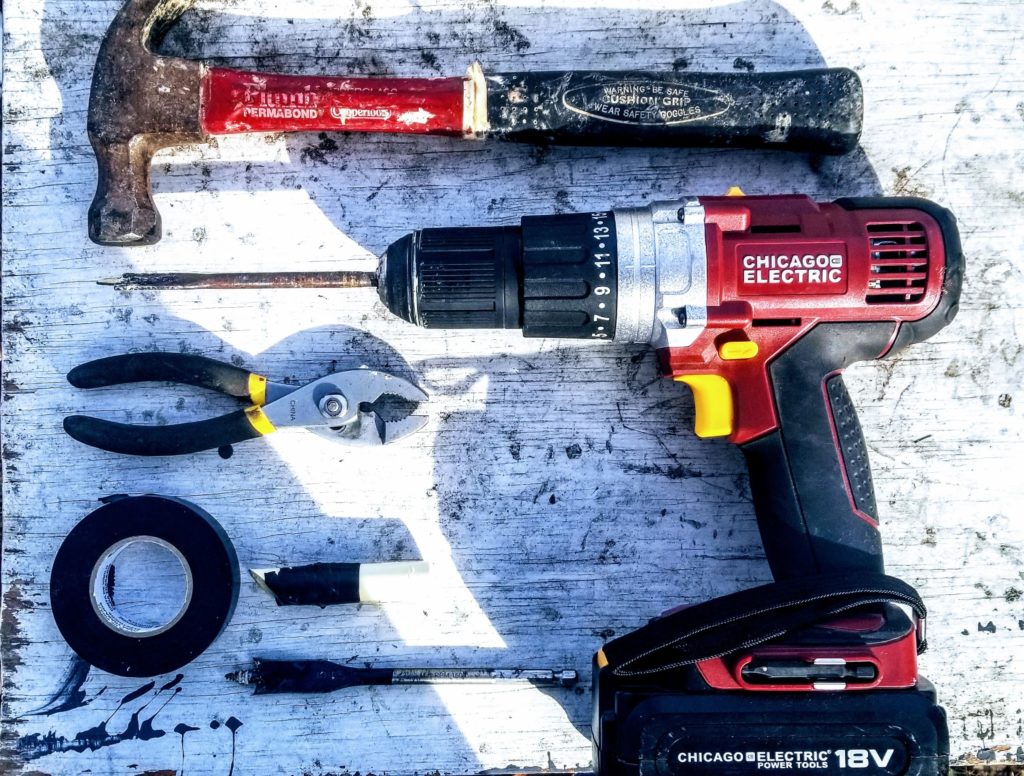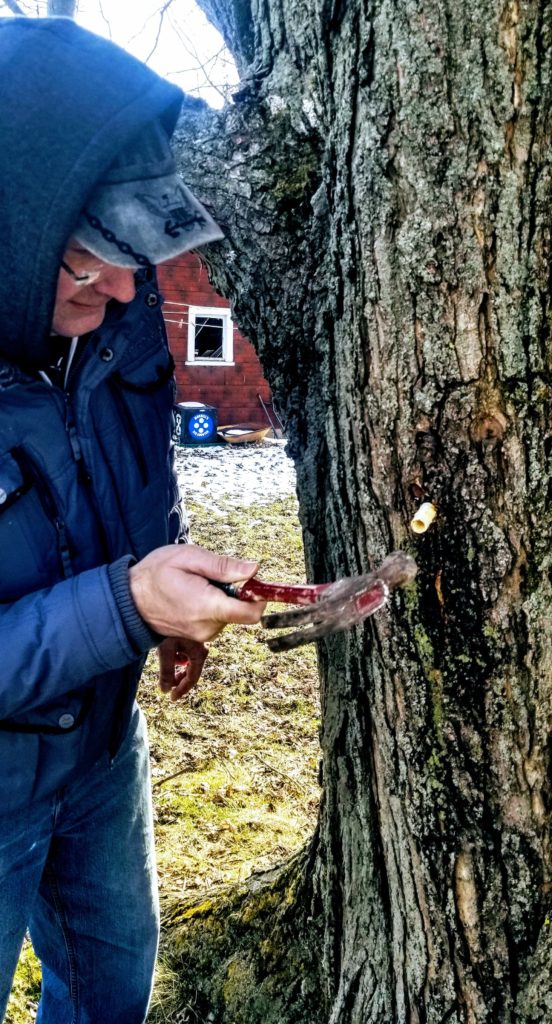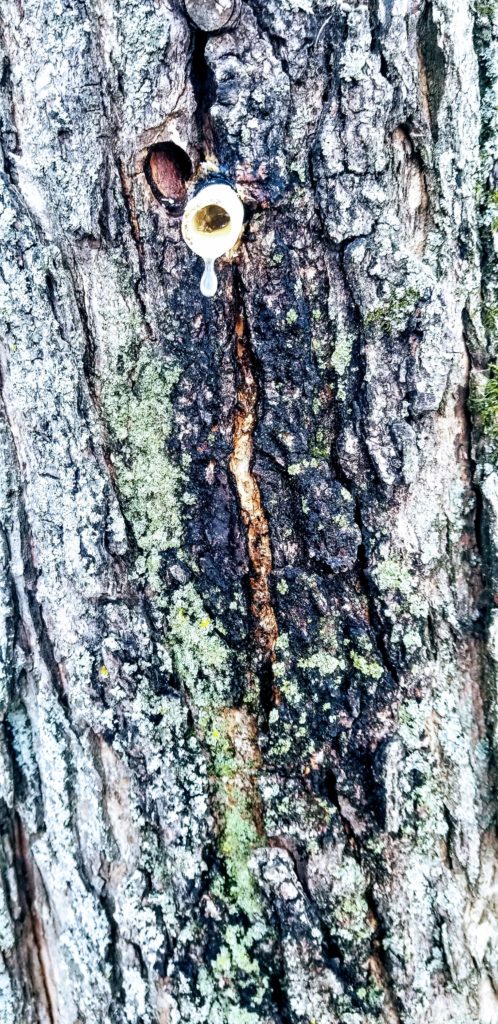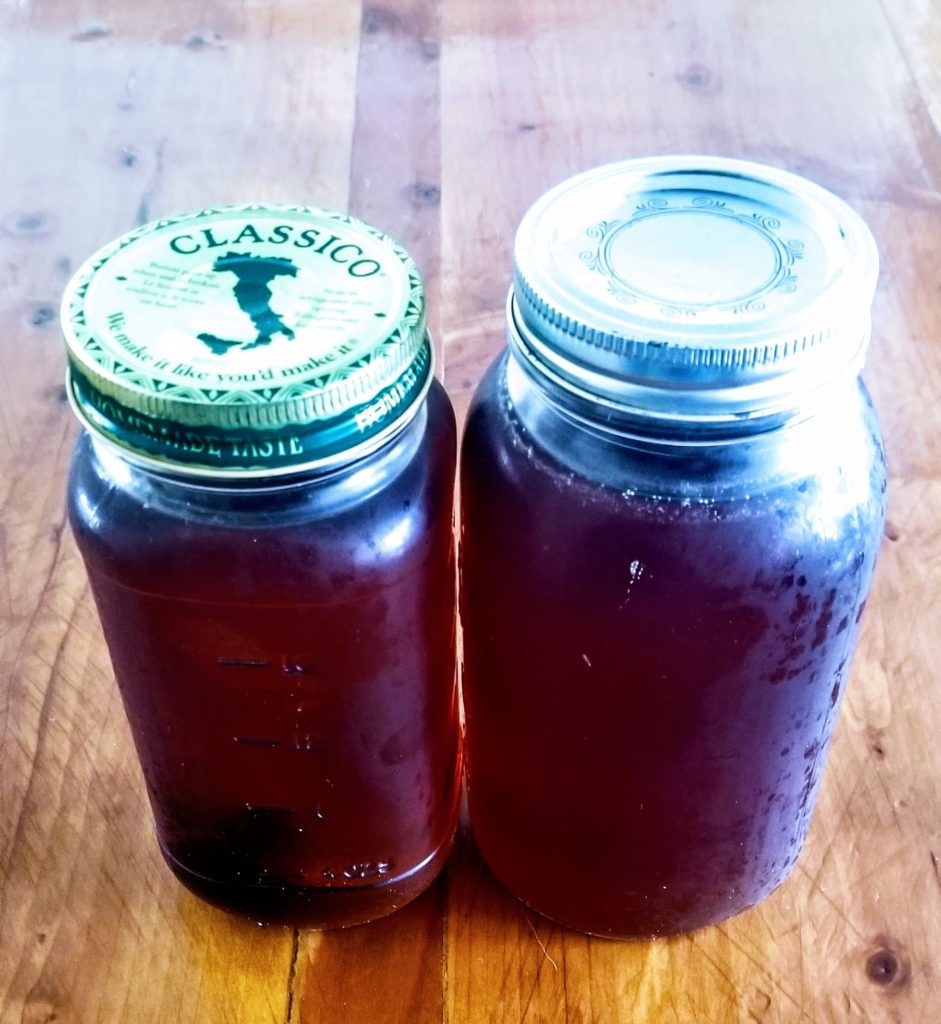By Jeffery L Carey Jr.
This year marks the fifth year my family has been making maple syrup out in our yard. It started with just a bit of curiosity and now it is something we look forward to every year. There is something incredible about getting outside and feeling the energy of the trees, the texture of the bark, and the maples awakening as they lumber out of hibernation.
Being thrifty types, we looked for the most inexpensive way to start utilizing the maple trees we had. After watching just a few YouTube videos on maple syrup production at home, we were confident that this was something that would be fun and easy to do.
Usually, we traipse out in the snow and the mud around the middle of February to tap our trees. It is often still very cold, but there tends to be a nice sunny day where you can go out and set up the taps. This day in the cold is well worth it as everything will be ready when the sap begins to run.

Four taps with buckets are placed on this giant maple in the Careys’ yard (Photo by Darlene Carey)
By the end of February many of the birds we enjoy watching begin to return and the maple sap begins to run as the days warm up, and the nights still drop below freezing. You can collect the sap all through the month of March, but sap collection ends when the buds begin to form on the tree. At this point the sap will become cloudy, starchy, and not useable for syrup.
Many websites suggest buying expensive equipment, but much of what you need may already be lying around at your home or be easily acquired for free.
The first thing you need is a maple tree. There are other trees, like the birch tree, that can be used for syrup and you can use any variety of maple trees, but the sweetest and most productive maple trees are sugar maples.
With Flint being nominated a “Tree City” for more than 18 years, there is a good chance you already have one of these trees in your yard. We were fortunate enough to have several maples in our yard with one of the sugar maples being a very large, old, and productive Acer. The important thing to note about your maple tree is that it must be more than 10” in width before you can start tapping it.
The next thing you will need is a spile or tap. The spiles used at a professional sugar bush will be made of metal, but we simply used some half inch pvc that we had at the house. The pieces were cut around four inches in length with one end of the spile cut at a 45 degree angle. We then wrapped the spile with electrical tape about an inch from the end of the spile which works to keep the tap snug and sealed in the tree.

Tools you will need for tapping the maple trees (Photo by Darlene Carey)
For collecting the sap you will also need buckets with lids. We bought six buckets from the hardware store, but if you want to be even thriftier many bakeries and grocery stores will give away buckets if you ask them.
Some other items that you will need are hooks for hanging the buckets on the trees, a hammer for pounding in the spiles, a drill and a bit for drilling the holes into the trees, and potentially some pliers for pulling the spiles out of the tree if you need to adjust them or for removing them at the end of the syrup making season.
Many people simply let the sap drip directly into the buckets. That is the traditional method for collecting the sap. We used clear flexible hose though for ours because this helps ensure that bugs and debris don’t get into the sap.

Author Jeff Carey hammers spile into tree until it is firmly in place (Photo by Darlene Carey)
When drilling the holes in the trees you want to find what looks like a vein running up the trunk of the tree and into a main branch. We drill our holes at a 45 degree angle about an inch to an inch and half deep. Be sure to clean as much of the saw dust out of the whole as possible.
Another important thing to consider is how you plan to boil down the sap. We usually boil around 25 to 30 gallons of sap each time we boil. Our five gallon buckets fill up on average once a week. It can get time consuming, but we make enough maple syrup to give a bunch away and still have enough syrup to last us all year long.
We tend to boil the sap outside and we have done this over an open fire before, but this year we are using a single electric burner outside. You want to boil the majority of the sap down outside so that it does not put too much moisture in your home. This process takes several hours, but the fragrance is incredible.
Also, we just went to our local thrift store and bought large kettles for boiling the sap. We only paid $1.50 each for two three gallon kettles. Many of the jars that we use for storing the syrup are jars we collect as we empty them, like gravy or spaghetti jars. They are easy to clean and sanitize and they can be reused many times.

Maple sap began to run as soon as the spile was placed in the tree (Photo by Darlene Carey)
Once we have boiled all of the sap down and only have about a gallon left, we move the boiling into the house. There we do the finish boiling on the stove. It becomes tricky at this point. The boil needs to be monitored carefully, and we learned this the hard way.
Using a food grade thermometer, the boil has to be monitored so that it does not go over 210 degrees. Once we were boiling and the temperature went too high resulting in the syrup “sugaring.” If you have ever pulled taffy, it had that consistency and then hardened into a burnt rock candy.
The key during the final boiling phase is bringing it right up to the 210 mark and then pulling it off the heat. You can keep doing this until it reduces down and thickens to your preferred consistency.
Our syrup begins very light colored at the beginning of the season and progressively gets darker. We like to filter the syrup also and blend all of the syrup together so that it all has the same color, sweetness and uniformity.
Getting back to our roots and producing our own syrup is immensely gratifying. If this is something that you are interested in, then you should surely give it a try. Also, if you don’t have maple trees in your yard, but would still like to get involved in making syrup then check out the many sugar bush activities going on at the For-Mar Nature Preserve and Arboretum at 2142 N. Genesee Rd., Flint.
Starting Mar. 14 – 21 there will be a variety of maple syrup activities going on at For-Mar, 810-736-7100. Plus it’s just an awesome place to get out and walk around in.

Maple syrup sealed in jars (Photo by Darlene Carey)
Banner photo by Darlene Carey
EVM Staff Writer Jeffery L. Carey, Jr. can be reached at jlcareyjr@hotmail.com. EVM Staff Writer and photographer Darlene Carey can be reached at darcar7@hotmail.com.


You must be logged in to post a comment.